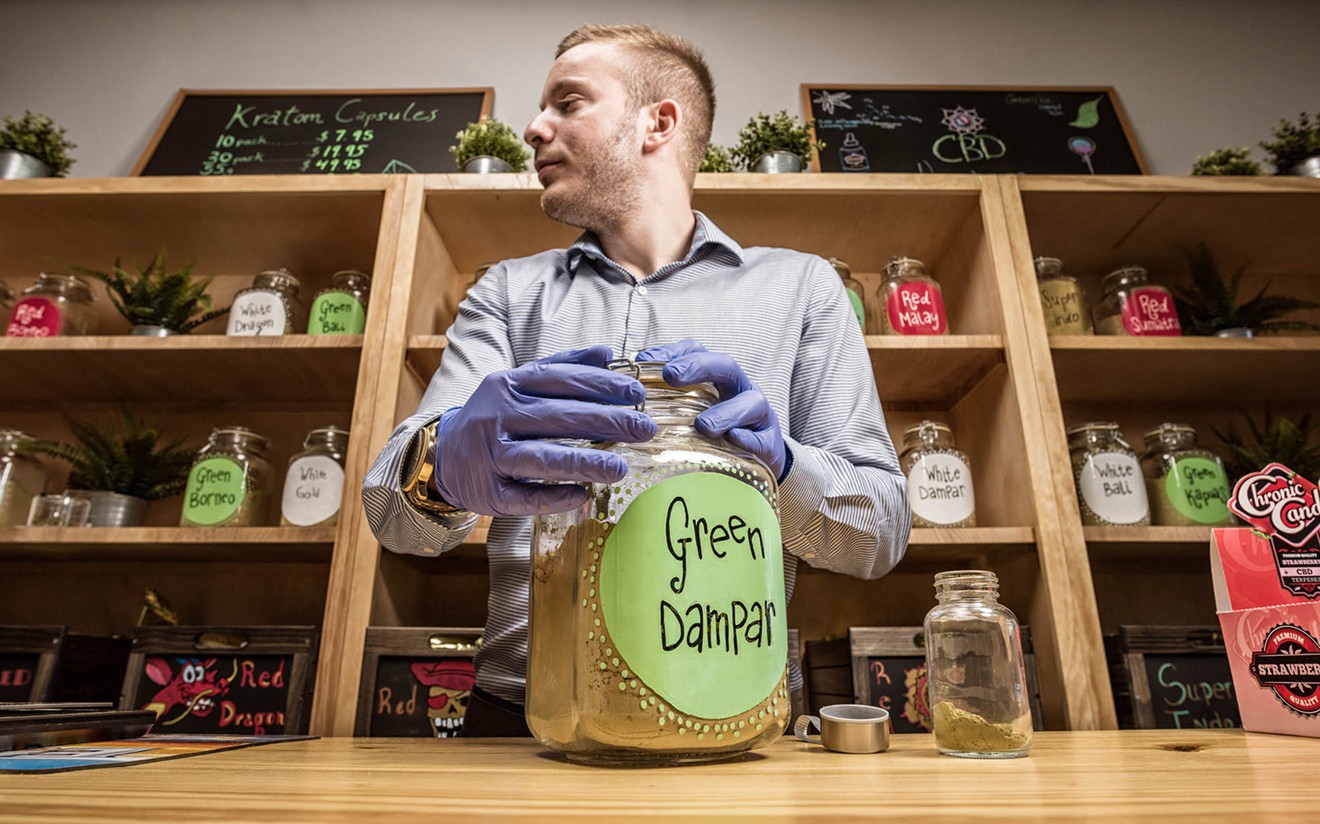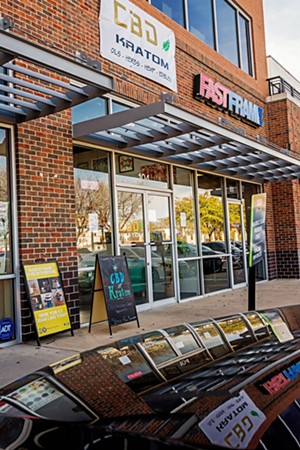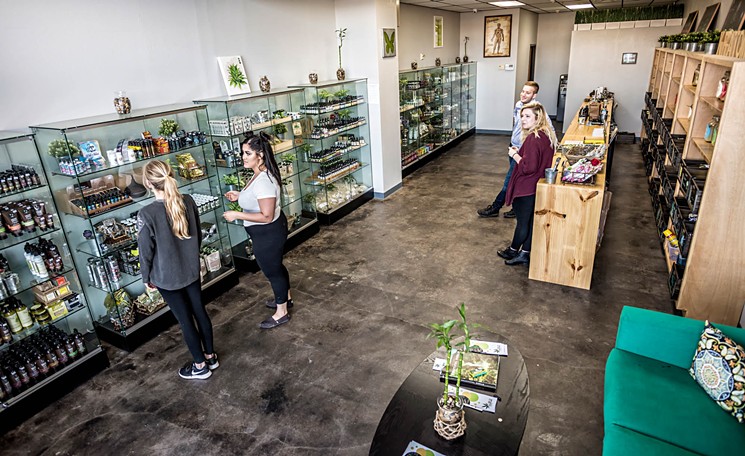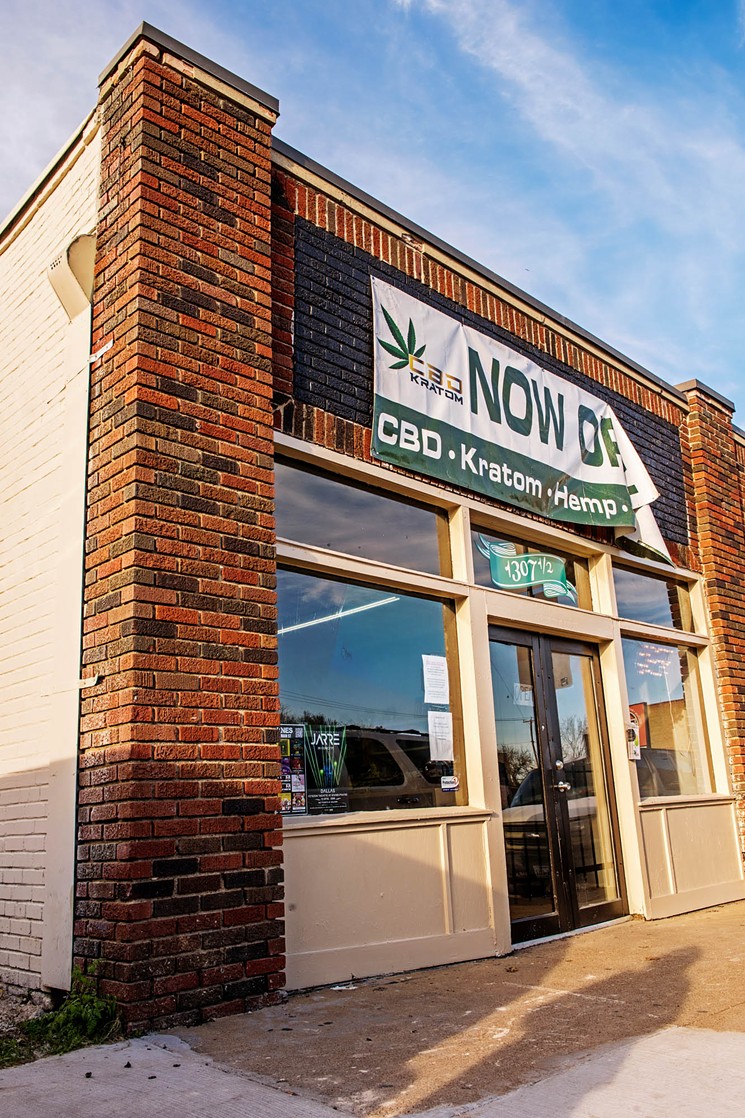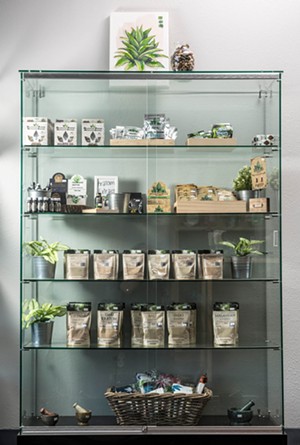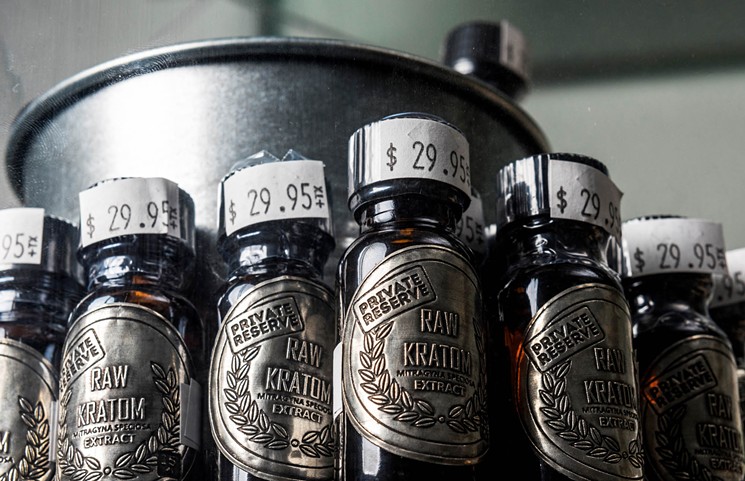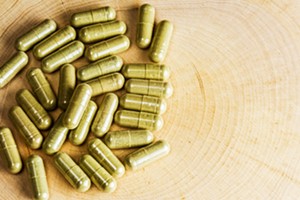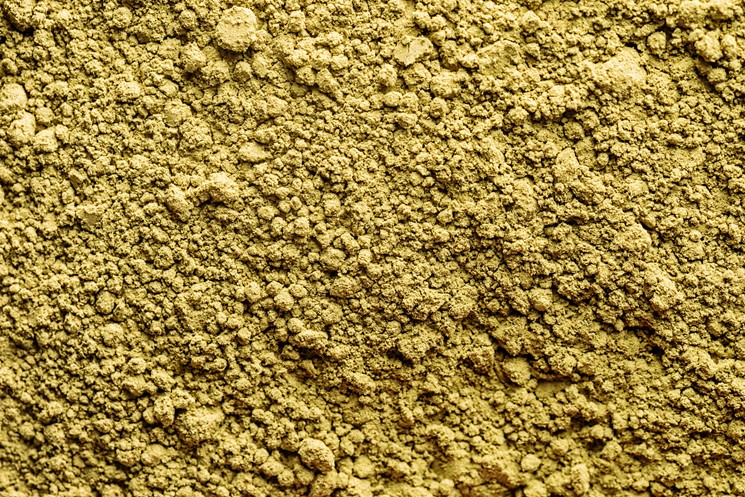At least not for the moment.
St. Louis native Revah and husband David Palatnik co-own a few successful smoke shops — that's a polite term for head shop — an endeavor that began with a store in St. Louis called Mr. Nice Guy. They added another in Chicago and partnered with a California dispensary that sells medical marijuana.
A shrewd, bold businesswoman, Revah remains sanguine despite having opened two dispensary-style boutiques in Dallas, both called CBD Kratom. Medical marijuana isn't legal in Texas, so don't expect to find kush at the shop on Knox Street or the second on Davis Street in Oak Cliff. Still, the name is ballsy considering the controversy surrounding kratom, a South Asian plant that many users hail as a potential life-saving herbal alternative to opioids.
While conventional head shops often camouflage controversial products, at CBD Kratom, these supplements stand tall. The small bags, jars and bottles of kratom are aesthetically packaged, benign looking, and customers rattle off praises for the plant. Unfortunately, kratom's fans don't include federal regulators. In February, the Food and Drug Administration threatened to stop kratom from entering the United States, and the Drug Enforcement Administration has threatened its legality.
Revah seems unfazed, but the government's threats have stirred fear and lobbying efforts among some of the countless Americans who are treating themselves for chronic pain with kratom. Some are convinced they will die without it, killed by the addictive narcotics that kratom purportedly replaces.
Kratom has been used since the 1800s for a number of purposes, including reducing the pain of opium withdrawal, but the FDA’s letter declared the plant dangerous and addictive.
Revah disagrees. Thousands use kratom for wide-ranging reasons — insomnia, coughing, pain, Crohn's disease. There is voluminous anecdotal evidence that the herb's subtle narcotic effects have bettered the lives of chronic pain patients and people dependent on prescription opioids.There is voluminous anecdotal evidence that the herb's subtle narcotic effects have bettered the lives of chronic pain patients and people dependent on prescription opioids.
tweet this
Right now, more than 2 million Americans are hooked on some variety of opioid. Overdoses from heroin and its more powerful synthetic cousin fentanyl claimed some 30,000 American lives last year. The Centers for Disease Control and Prevention estimate opioids will kill another 52,000 Americans this year and as many as half a million in the next decade.
Revah says she worries for the people in pain. "It's sad," she says. "They do not want to addict themselves to oxycodone, so they come buy kratom. Taking it away would be very bad."
As feds require, CBD products in her shop — oils, creams, capsules, edibles and waxes — contain less than 0.3 percent tetrahydrocannabinol, the chemical that produces marijuana's high. Regardless, consumers and sellers say CBD goods produced from hemp can relieve pain and inflammation and reduce anxiety and nausea.
At Revah's shops, educated, friendly staffers won't hover but usually are on hand to answer questions. The space resembles the sterile, practically clinical environment of legal marijuana dispensaries found throughout Colorado and other states.
CBD sales are carrying on with minimal fuss. The lesser-known kratom, however, is fighting for its legal life.
Why Stop Kratom?
In 2012 and again in 2014, FDA import reports included mention of kratom, indicating the agency felt it had enough evidence to warrant stopping it at the border. Since 2014, federal law enforcement officials have seized at least $5.5 million worth of kratom, according to the FDA.So kratom disappeared from shelves of American shops, and most of the industry moved online. A growing contingent of users bought from "trusted" online vendors. (Scammers promptly were called out on kratom forums.)
And merchants placed labels like "incense: not-for-human-consumption" on bags and boxes before shipping them overseas.
In spring 2016, the DEA announced plans to make kratom (more precisely, its two primary psychoactive compounds, mitragynine and 7-hydroxymitragynine) a Schedule 1 drug under the Controlled Substances Act. That's the category reserved for the worst chemicals that are medicinally irrelevant and have the highest potential for abuse — heroin and ecstasy, for example. It would mean an all-out ban.
To the thousands of Americans who treat pain with kratom, the news ignited fear and indignation. Online vendors, who spent the previous few years booming in business, stood to lose thousands of dollars in sales and inventory or risk becoming criminals.
Protests, letters, videos, petitions — the outcry was more than the government expected, and Congress stalled "for an FDA analysis."
Still, CBD Kratom opened its two Dallas stores earlier this year, and the herb is on gas station counters again.
Producing stimulant or depressant effects at varying doses, kratom is an unusual compound. Its voyage has been as peculiar.
In the 1800s, amid the humid thickets of Southeast Asia, laborers discovered kratom (Mitragyna speciosa) leaves growing — broad, glimmering green in tall tropical trees. The vegetation, when nibbled upon, eased pain and increased energy.
Around that time, it first was documented as a potential opium substitute. In Thailand, it became "part of the ritual worship of ancestors and gods," Darshan Singh noted in "Traditional and non-traditional use of Mitragyna speciosa," which surveyed and summarized dozens of published studies conducted in Thailand.
Extracts from the plant found use as a local anesthetic and a treatment for coughs and intestinal infections. The stuff reportedly staved off pain, depression, exhaustion, coughing and dysentery. Users described feeling happy, creative, energetic and even horny, according to "The pharmacology and toxicology of kratom," published in the 1996 International Journal of Legal Medicine.
Enterprising sharecroppers figured its recreational, feel-good effects meant money, especially if peddled outside Asia, where the plant did not grow. In the late '90s, kratom spread to America and was touted as a euphoric "legal high" on shelves in head shops.
"Were it further regulated or banned, kratom would become even more difficult, virtually impossible, to analyze." – American Kratom Association President Susan Ash
tweet this
The brown plant extract came as dirt-flavored dust inside colorful containers. Bright, playful fonts read "Purple Sticky Stuff" or "Captain Kratom." A dose or two went for $20 to $25.
Wayward marketing maybe cultivated its ill repute, as did its listing on the DEA's "drugs of concern" resource guide, which made it tough for medical researchers to study its lifesaving or harm-reducing potential. The National Center for Complementary and Integrative Health denied a grant request to study kratom, explaining that the foundation does not fund the research of "hazardous materials."
"Were it further regulated or banned, kratom would become even more difficult, virtually impossible, to analyze," American Kratom Association President Susan Ash warns.
That's one of the many catch-22s in America's approach to drug regulation. Because plants such as kratom or marijuana lack acceptable studies demonstrating their value as medicine, the DEA can declare the drugs medically useless, making it virtually impossible for researchers to actually study them, according to University of Mississippi’s Chris McCurdy, a researcher studying drug withdrawal and kratom, in a 2016 Scientific American article. “Not many of us [researchers] have a Schedule I license,” he notes.
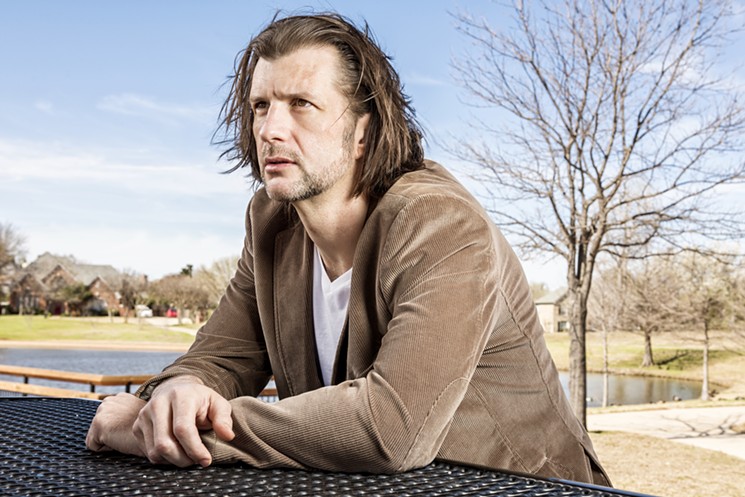
Fighting Pain and Fighting Back
Among those working to promote the plant’s goodness and educate users and vendors is Anthony August Larson, a Dallas resident, disabled Marine, a trained herbalist and one of America’s staunchest, most outspoken and organized advocates for kratom’s legitimacy and continued legality. He is hell-bent on changing that “legal high” perception.Because of condition that caused constant back pain, Larson says he relied on morphine prescribed by doctors in order to function. He learned about kratom when traveling in Indonesia, after he ran out of pain pills and sought out a prescription. Instead of pharmaceuticals, the doctor gave him kratom. After kratom, he says, he dosed less morphine and quickly quit craving it.
In the early '00s in Seattle, he worked at a Veteran Affairs hospital, where, he says, he learned some of the more traumatized soldiers were using kratom.
"They had heard of it — some of them — he says, but they were buying it at head shops at these insane markups, so I would give it to them," he says.
Larson says he could see their demeanor, confidence level and general wellbeing transform with a combination of kratom, other doctor-recommended treatment and counseling.
In 2003, he launched a project called KratomDocumentary.com. It's a website containing hundreds of interviews with all manner of people lauding the benefits of kratom.
He wanted to start this, he says, because he could see what was coming.
"I am a capitalist, not a conspiracy theorist," Larson says. "But it doesn't take a genius to see that if a cheap plant stands to diminish the need for billions of dollars in pharmaceutical sales, well, someone decided it was time to make it go away."
Scientific research is preliminary at best, but anecdotal evidence related to kratom abounds. Larson has been collecting and documenting testimonials, and he says he constantly is surprised and impressed by what he hears."It doesn't take a genius to see that if a cheap plant stands to diminish the need for billions of dollars in pharmaceutical sales, well, someone decided it was time to make it go away." – kratom advocate Anthony Larson
tweet this
Spencer Owens at 43 was preparing for a total hip replacement.
"It had been two years living uncomfortably since I was diagnosed with this hip problem," he says. "They determined I had no cartilage left, a torn labrum. It couldn't be fixed with arthroscopic surgery, so I was going to have this major operation."
After a second opinion, Owens, an active, scarcely middle-aged man, rejected the invasive procedure and opted for physical therapy, weight loss and pain management using narcotics such as hydrocodone and oxycodone.
The latter option seemed considerably safer, at first.
As the American opioid crisis began dominating news headlines, Owens questioned his reliance on narcotics for relief. Even more disturbing, Owens' body adapted to his prescribed doses. The pills worked wonders at first. Then his physiology changed, and his body grew accustomed to the medicine. The pain increased.
He lost weight and performed agonizing therapeutic exercises, but his hip did not improve, and every few weeks, his pain medication lost effectiveness. Like millions of legitimate chronic pain patients, he was at the mercy of doctors when it came to controlling his pain. Hospital visits became nerve-wracking ordeals.
As the opioid epidemic worsened, the DEA imposed limits on doctors prescribing or ordering controlled substances, so physicians fear prescribing enough medicine to adequately treat patients' pain.
Within two years, Owens could hardly walk — physical therapy, jogging, outings with the dog all became unbearable without strong narcotic analgesics, which, to make everything worse, also made his head "fuzzy." And he battled to bury this nascent apprehension that even if his hip magically healed, his body would demand the pills all the same.
Frightened about his steadily growing reliance on the drugs, fed up with feeling foggy all the time and worried antsy prescribers would cut him off, Owens began looking for an alternative.
People in pain can grow desperate for relief. Moms, teachers, lawyers, cops — anyone in physical agony is capable of things they never imagined.
A single mother of two leaving CBD Kratom in Oak Cliff (we will call her Cheryl; she only agreed to chat anonymously) works in an expensive, exclusive preschool by day and picks up occasional nighttime catering or bar-tending shifts.
A few years ago, she began experiencing severe pelvic pain. The petite, freckled strawberry blonde, 32, is resilient to the core, and she regularly runs herself ragged, forever fighting misery.
"It hurts physically, yeah," she says, "but it makes me sad too, depressed even. I want to do things, like with the children, and … [gazes down at shaky hands, folded in her lap] I just can't."
When she was 30, doctors diagnosed interstitial cystitis, a painful bladder condition with no cure but some moderately effective treatment options. She tried nerve stimulation, physical therapy and anti-inflammatory drugs, antidepressants, and — finally, reluctantly — narcotics.
She spreads paperwork across a table, her documented diagnosis with instructions, prescriptions, insurance letters and specialists' phone numbers — a cache kept in a bound, pocketed journal.
As with Owens, Cheryl's opiate regimen worked — for a time. By winter 2017, she needed something stronger because her tolerance had increased. She had to work double shifts to cover bills and put presents under the tree. But her doctor refused to prescribe stronger meds. In fact, he told her he planned to wean her off the narcotics. He had few options.
When your body hurts all the time, "this plague, the crisis, outbreak everyone's talking about — it means very little to you, personally. All you can think about is your own pain, sleeplessness and frustration," she says, tears streaming.
Despairing, Cheryl first committed a crime of opportunity: she swiped an old, barely touched bottle of oxycodone from a relative's medicine cabinet.
At a Christmas party she worked last year, a bartender at the end of a shift snorted a tiny bump of beige powder. Heroin. She was hurting so badly she could hardly think.
The bump of heroin up her nostril felt just like morphine, she recalls telling her pusher. "It's basically the last thing I remember before waking up in a hospital bed, a tube down my throat, dried vomit in my hair."
She would have died without a shot of naloxone, the drug that reverses opioid overdose, at the ER.
In the white room, Cheryl drew her knees to her atrophied, aching tummy. At midnight two days before Christmas, she brought her smartphone close to her blurry eyes and scoured the internet for alternatives to opiates. Anything, she wept. Trembling — exhausted to the bone but wired "like a speed freak" — she mussed the sheets, soaked them in sweat, snot and tears.
Her fumbling fingers after a few minutes took her to Reddit.com and the site's kratom forum, where she read narratives she could have typed herself.
"I could not believe there were this many of us out there," she says.
Some of the sub-Reddit's 40,000 members said they took the herb for physical relief while others called it the antidote to anxiety and depressive disorders.Some of the sub-Reddit's 40,000 members said they took the herb for physical relief while others called it the antidote to anxiety and depressive disorders.
tweet this
To her amazement, self-identified "junkies" — one after another — wrote of weaning themselves off all manner of pharmaceutical narcotics.
She read the reviews, inspected vendors and, in an attempt to save her life, or at least any semblance of its quality, ordered a bag of powdered plant. She relied not on physicians but anonymous mentors — Weezer2040, BisonPuncher, Drunkendolphin1, MichaelKeaton.
She felt different — hopeful, even — when that first teaspoon took effect 15 minutes after she ingested it (place powder on tongue, drink full glass of water or orange juice, do not puke) a few days after Christmas.
"It was gentler than oxycodone but eased all my tension in the most painful areas; the agony, oh my God, the agony, eased up," she says.
She alternated oxy and kratom, but within a week or two, she says, she preferred kratom. Not only did it alleviate the pain, but also she found herself smiling, playing with the children. She did not feel foggy when driving to school, work, overtime gigs. She somehow felt safer, she says, and cleaner — although she was chugging a teaspoon of dirt every four to five hours.
When the pharmaceutical drugs ran out, she experienced withdrawal symptoms from oxycodone. But instead of the norm — shaking, freezing, sweating, pounding heart, panic, vomiting, feeling as if her skin was inside out, each nerve exposed — she says she dealt with irritability, runny nose, chills and a little trouble sleeping for about a week.
Owens, too, sought alternatives, but not in street drugs. Rather, he looked into homeopathic and herbal supplements.
His search, much like Cheryl's, led the Dallas man to kratom.
Owens' description of his kratom trial, also like Cheryl's, seems too good to be possible. He feared his first dose was a dud, he says.
"But when I increased my intake just a little, it did wonders," he says. "It relieved my pain without any intoxicating effects, and I thought, I have found something that works. And it curbed my cravings for narcotic pain medicines. In fact, it just pretty quickly cut out my use of them altogether."
He conferred with his physician, he says, but the doctor had never heard of kratom. If some herbal supplement helped him, the doctor told him, go for it.
He has been self-medicating with kratom ever since, he says. "I kinda don't know what I'd do without it," Owens says. "I've done endless research on this by now — most controversy about kratom is due to lack of knowledge."
Stirring the Masses
The DEA drug scheduling announcement of 2016 brought kratom users out of hiding — protests in Washington, hometown rallies (a couple hundred people showing up at many, especially when Larson went with his camera) — to record more web testimonies:"I work a full-time job now," a 40-year-old woman says. "I raise two kids all by myself without feeling drugged out because of pain pills."
"Tried everything from surgeries to acupuncture for 13 years, finally discovered that opiate pain meds work — 60 milligrams of oxycodone per day," an older man says, "but now doctors bullied by the DEA don't want to prescribe. Kratom has been an absolute lifesaver … but if they take it from us … what then?
DEA scheduling could prove devastating for the thousands of Americans self-treating pain and other ailments, those weaning themselves off opioids such as hydrocodone, oxycodone, morphine and fentanyl, and it would essentially put a stop to research on humans.
Even Trae Crowder, the comedian known as Liberal Redneck, spoke up: "This is deeply personal to me. My momma's a recovering addict. Pills. Hillbilly heroin, Percocet … the DEA just did something that will make it even worse … an epidemic that no one is doing anything about, partly because it effects mostly poor people. and everyone knows poor people are super gross. … Pills are as bad as any drug out there. I've seen it. They have made a lot of dirty people a lot of dirty money."
Larson says he was caught off guard when the stories of opiate withdrawal treatment began to emerge. People did not want to talk about that at first, but when they did, it was a floodgate, he says.
"What an opportunity during an opiate crisis in our country!" His enthusiasm, if possible, intensified.
But the FDA's announcement, which released results from the promised further study of kratom, was a kick to the gut. FDA administrator Scott Gottlieb cited "44 reported deaths associated with the use of kratom [among other drugs, since 2011]." He continues, "There is no evidence to indicate kratom is safe or effective for any medical use." And he stated that the supplement "isn't just a plant — it's an opioid."
Ash, president of the AKA, says there's more to the numbers.
"They are saying 44 people died from a range of causes and that they had kratom in their system. It's like blaming fatalities on coffee because 44 people who drank coffee died today," she says.
Larson puts it like this, acknowledging kratom can indeed make one sick, or, combined with other drugs, dead: "So say you order kratom from some rando off the internet and you get sick, throw up, dizzy," Larson hypothesizes. "Some vendors just do not care. Others do not actually know about keeping their product pure and clean.""They are saying 44 people died from a range of causes and that they had kratom in their system. It's like blaming fatalities on coffee because 44 people who drank coffee died today." – Susan Ash
tweet this
Larson travels the country talking to sellers and, if they will have him, letting them know how to properly wash and prep their inventory. Some — especially the "hippie types on the West Coast" — truly care about their clients and kratom's image, he says. The point: Kratom isn't causing illness; it's contamination or adulteration somewhere along the way.
"But when the ER doc asks you what you took, you say kratom, they call poison control and we have another 'adverse incident' on the books," he says. There is not one record to date of a kratom-caused death, he insists. Not from kratom alone. Mixed with other drugs and conditions, yes, apparently 44.
Kratom-associated death, according to the FDA, can include something like this: A 43-year-old man suffering severe complications because of deep-vein thrombosis had a long list of medical problems, including chronic back and shoulder pain and a history of alcohol and prescription drug abuse. Toxicology tests returned positive for opioids, benzodiazepines, antidepressants, a medication used to treat Tourette's syndrome and kratom. The FDA listed his death among "kratom-associated" fatalities.
Among deaths of people who are chronically ill, drug addicts, abusers of illicit substances, patients undergoing treatment for a variety of mental illnesses among them, 44 have involved kratom in some manner, backing evidence that it is potentially deadly, Gottlieb insists. But people do not die from kratom, Larson says. Not from just kratom. It does not depress breathing as other opiates do.
"No one, not a single person, has died by kratom use alone," Larson says. "The kratom-related deaths they point to, in every case, involve other illicit or prescription drugs, alcohol or some major underlying condition.
"If I took way too much kratom, and I did take three times too much at first because the consistency was different from what I knew in Indonesia, I would feel nauseated, might vomit, might get a headache and go to bed," Larson says. "In a few hours, I'd be fine. Do the same with oxy, fentanyl, heroin — not so. You are probably going to die."
Even allowing for these 44 kratom-related deaths in America since 2011, that pales compared with the anticipated more than 50,000 deaths expected from opioid overdoses this year. This doesn't mean kratom is always safe, either. Kratom bought online can be contaminated or adulterated with other substances, possibly to hook customers.
A smaller sub-Reddit focused on quitting kratom contains heart-tugging tales and conversations among kratom users who feel they have lost control and want to stop and others who say they have been physically addicted but tapered off. They experienced similar symptoms to those detoxifying from heroin — diarrhea, agitation, chills, sweats, insomnia and restless leg syndrome — but to a lesser degree, according to member I_Wise. One woman says all was fine until she purchased a so-called "enhanced" tincture.
"Then I was like a heroin addict," she says. "There are products out there one must stay away from — do your research."
About 4,000 members belong to the quitting kratom sub-Reddit. "We are a group of people dedicated to helping each other kick the kratom habit," its administrator notes.
What better way to be able to hold your kratom vendor accountable than selling it from a storefront, Larson asks rhetorically, expressing excitement about Dallas' new brick-and-mortar shops. "As long as they are honest with people, don't gouge people, educate consumers, I think it is great. I mean, you are going to pay a little more for the overhead and security," he says, adding that he wants to meet the owners.
Although kratom is not a magic cure and there are risks (dirty vendors, adulterated products, evidence of addiction potential, and more), its possibilities seem to shine most brightly in matters of harm reduction, an emerging movement in which the main goal is to not die. Stay alive, and there is always a chance — it's a phrase often heard in 12-step meetings.
Alcoholics Anonymous and Narcotics Anonymous, the mainstays for addiction recovery, do not consider a person using any mood-altering substance clean or sober. It's a problem because there is no instant cure, says one former NA member shopping for kratom. "If you want to fully recover, you must have spiritual, therapeutic support as well as medicinal treatments," he adds.
Positive Research
A couple of university professors, whose research focuses on design, synthesis and development of drugs to treat pain and drug abuse, concentrate on opioids and have studied kratom as a replacement for methadone, a powerful opiate used for long-term weaning off heroin, morphine, oxy, fentanyl and the like. Kratom can touch the brain's opiate receptors, creating a similar, if subtle, narcotic effect. However, unlike every other opioid, including maintenance drugs such as methadone and Buprenorphine (pharmaceutical, long-acting, expensive opiates the FDA champions as the only approved medicinal treatments for withdrawal syndrome) kratom does not cause any significant respiratory depression.Dr. Edward W. Boyer, professor of emergency medicine and director of medical toxicology at the University of Massachusetts School of Medicine, collaborated on a study with Christopher R. McCurdy, then at the University of Mississippi. They discovered the plant's most abundant alkaloid, mitragynine, and tested the pure compound on lab mice.
"Results indicate this compound's activity is superior to methadone in treating withdrawal … and that carefully created chemical variations may provide an alternative to methadone in treating addictions to opiates," McCurdy determined. "Mitragynine completely blocked all withdrawal symptoms and could provide a remarkable step-down-like treatment for people addicted to hardcore narcotics such as morphine, oxycodone or heroin. The compound has been known for years, but we're working to come up with an improved synthetic analog or a better formulation of the tea for testing in humans.""Results indicate this compound's activity is superior to methadone in treating withdrawal … and that carefully created chemical variations may provide an alternative to methadone." – researcher Christopher R. McCurdy
tweet this
Opioid analgesics kill so many people because the medicines can lead to respiratory depression, Boyer says. "When you overdose on these drugs, your respiratory rate drops to zero. In our animal studies where rats were given mitragynine, those rats had no respiratory depression. This opens the possibility of someday developing a pain medication as effective as morphine but without the risk of accidentally overdosing and dying."
Revah says she wants anyone who needs kratom or CBD to have access. Some of the people who need or want to try kratom, for example, are older people who are not comfortable walking into a head shop and asking for a product the DEA called hazardous and almost banned.
"We are here to put our clients at ease," she says. A customer or two have complained about prices steeper than they find online, but the stores are drawing curious newbies and thankful longtime users. Sometimes it's just about relaxing with a little kratom tea after a long week, she says.
She understands the risks of building a business around a product that just a year ago was one step away from being outlawed. She is prepared for pushback. Although the couple's multiple stores, including Mr. Nice Guy, generate more than $1 million annually under their M&G umbrella, they would not have opened a kratom store if they did not think it would remain legal, Revah says.
The FDA and DEA, she says, are lying. "They say they want to save people dying from opiates and unbearable pain — well, we feel they aren't doing their job, and this war against kratom certainly is not going to help a thing."

